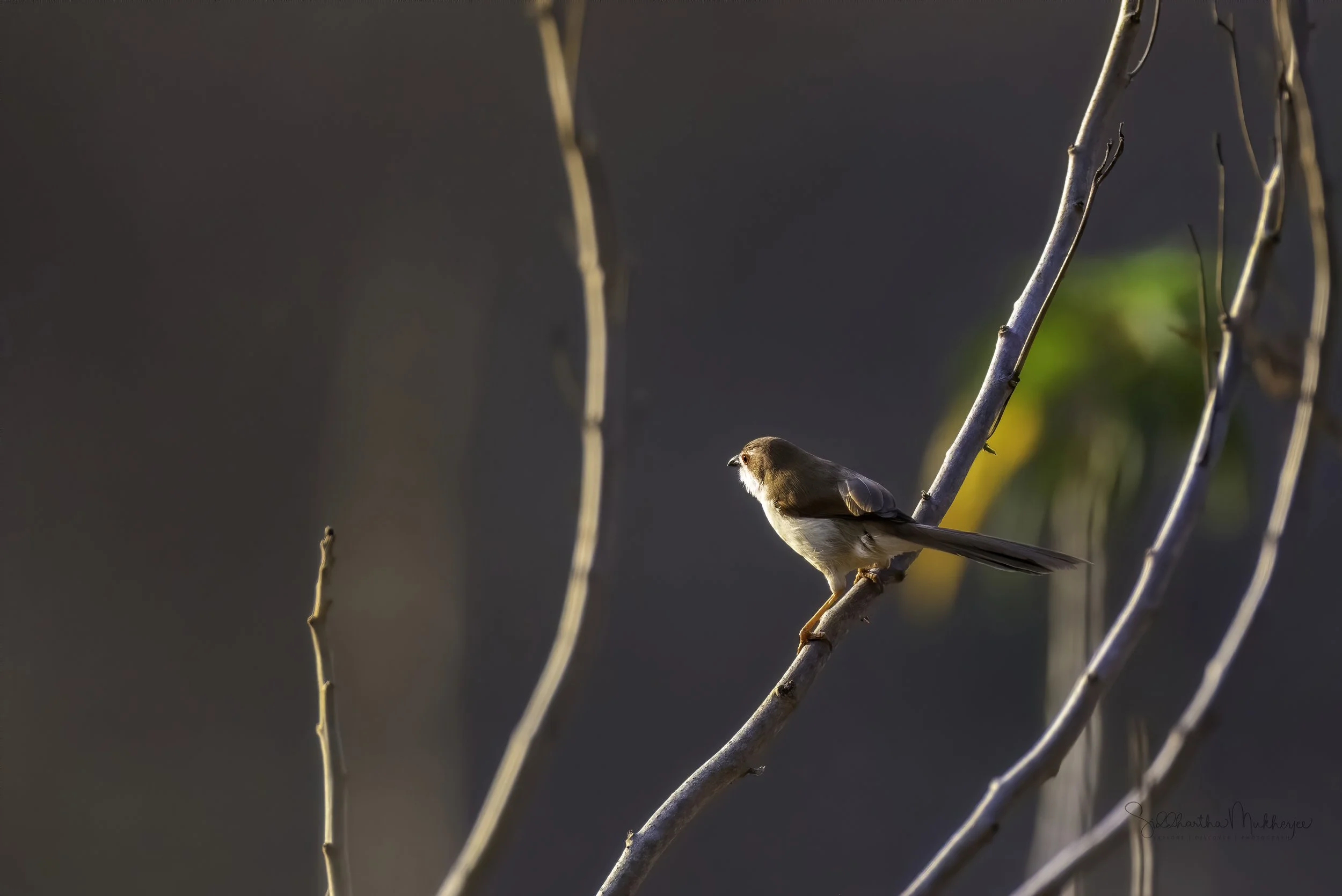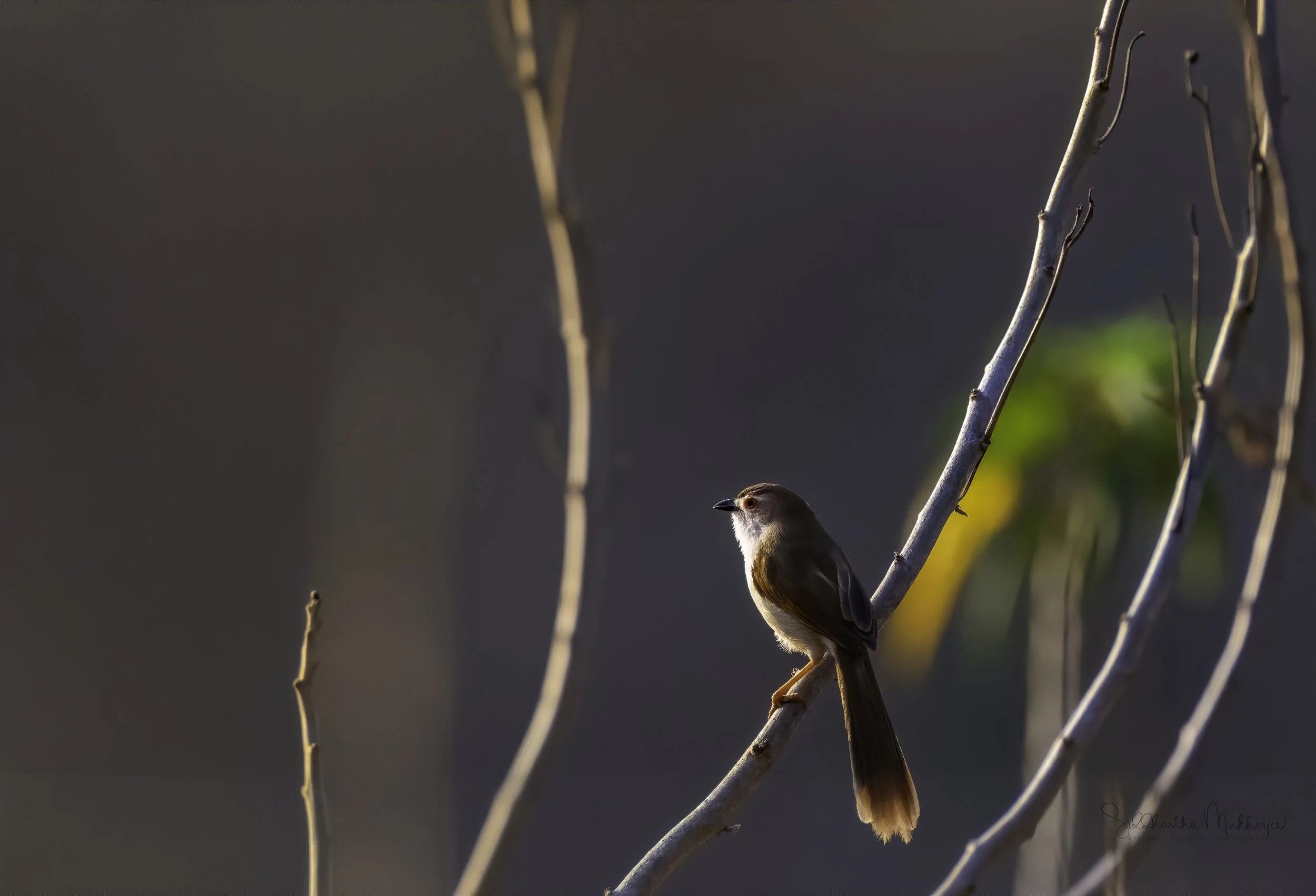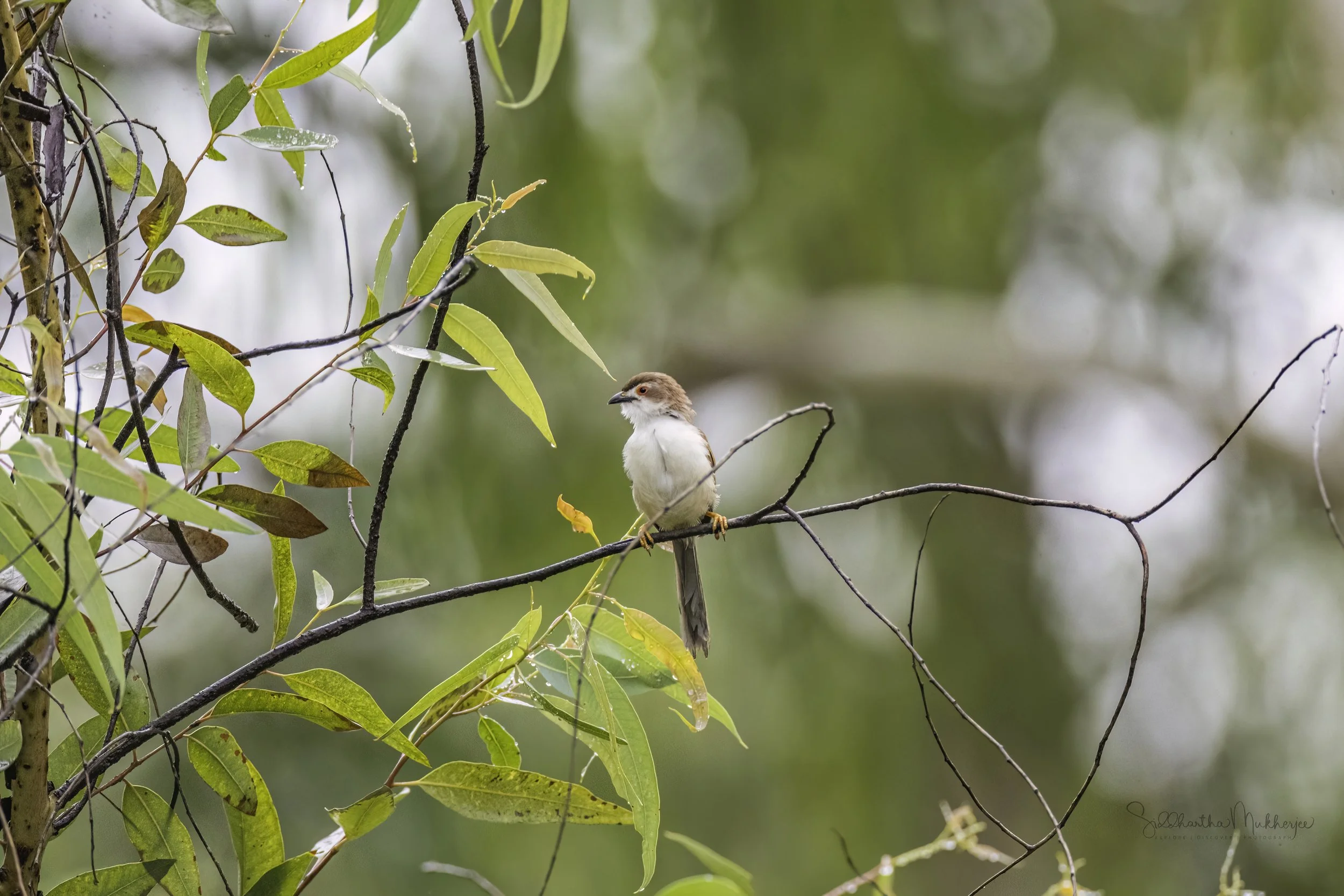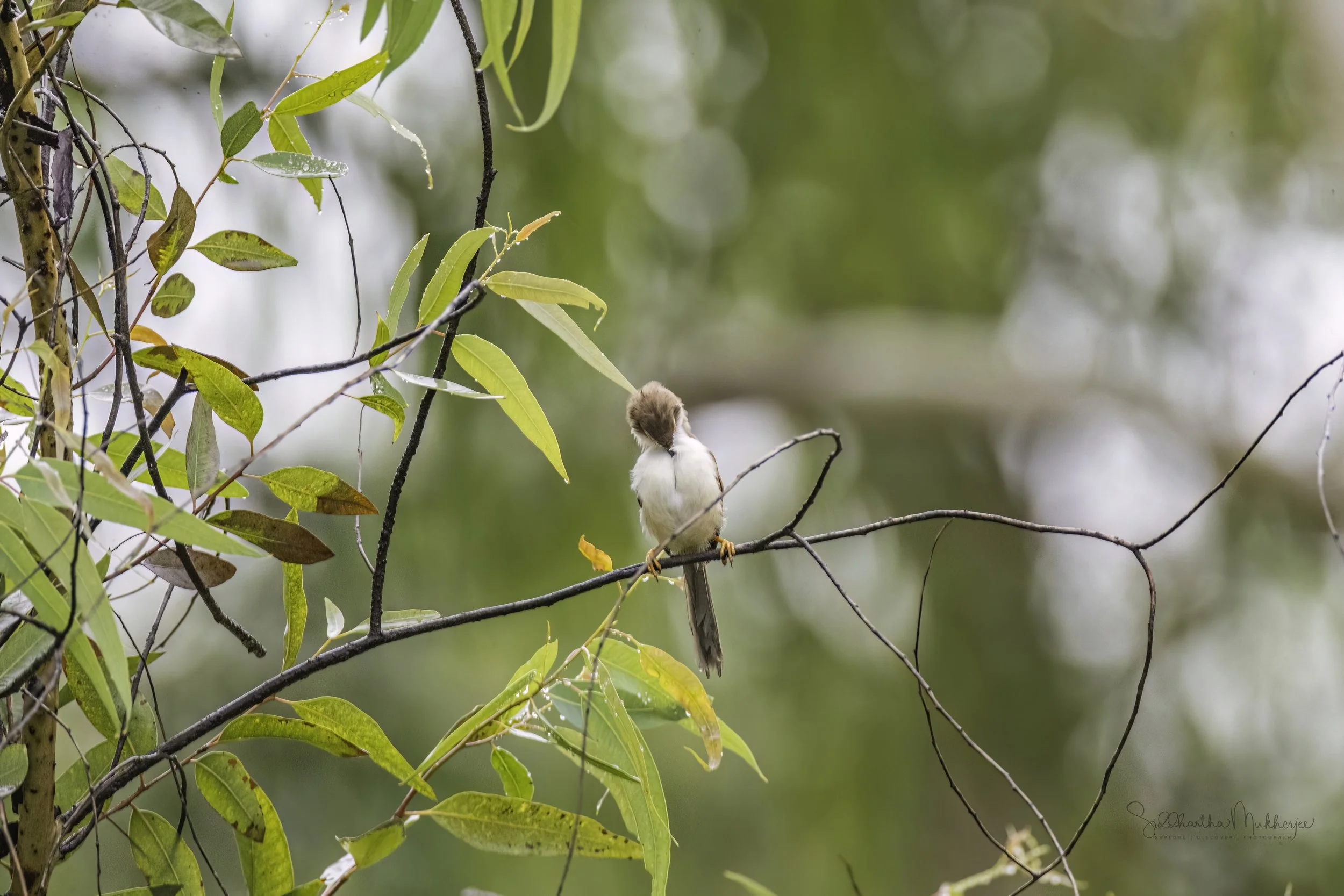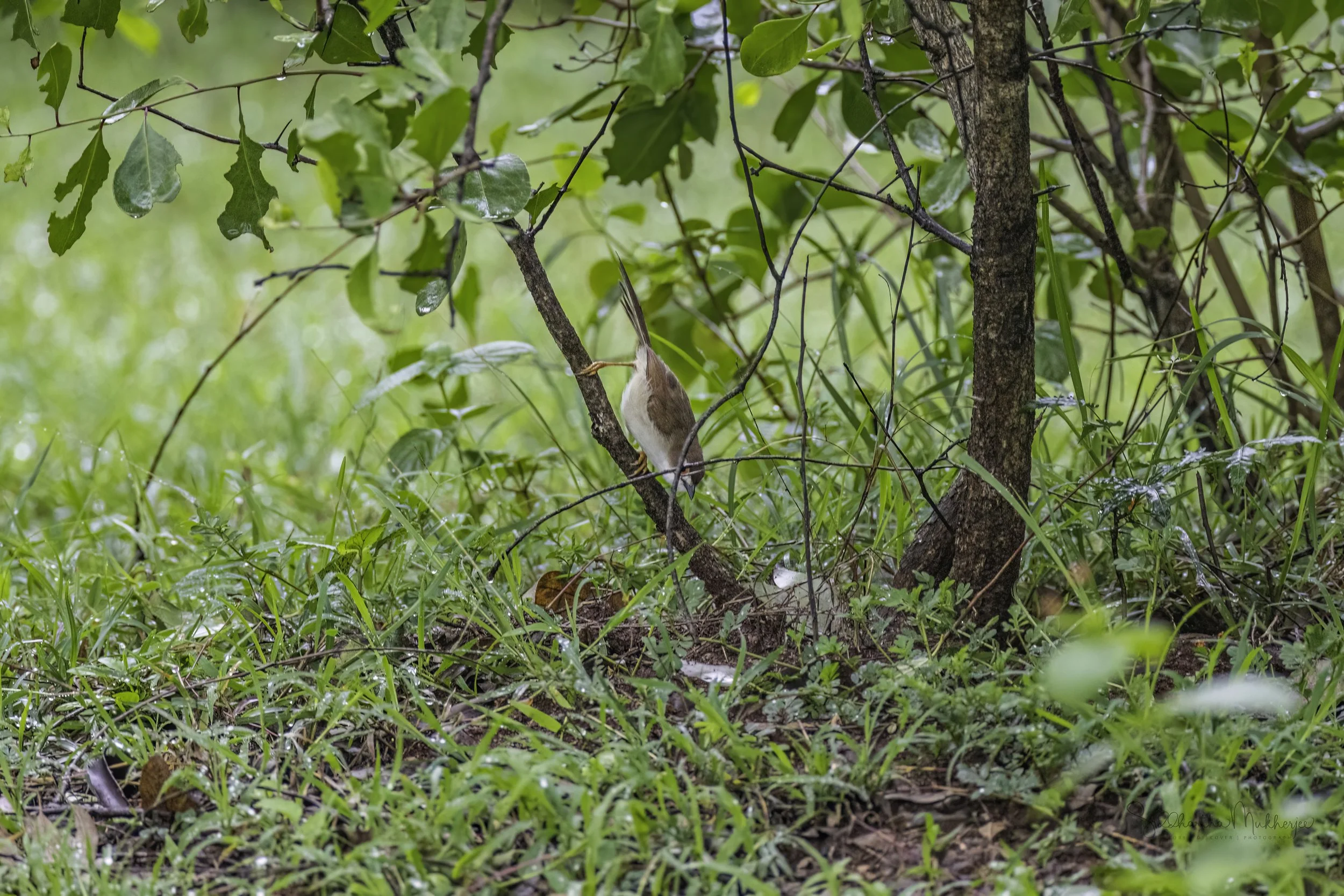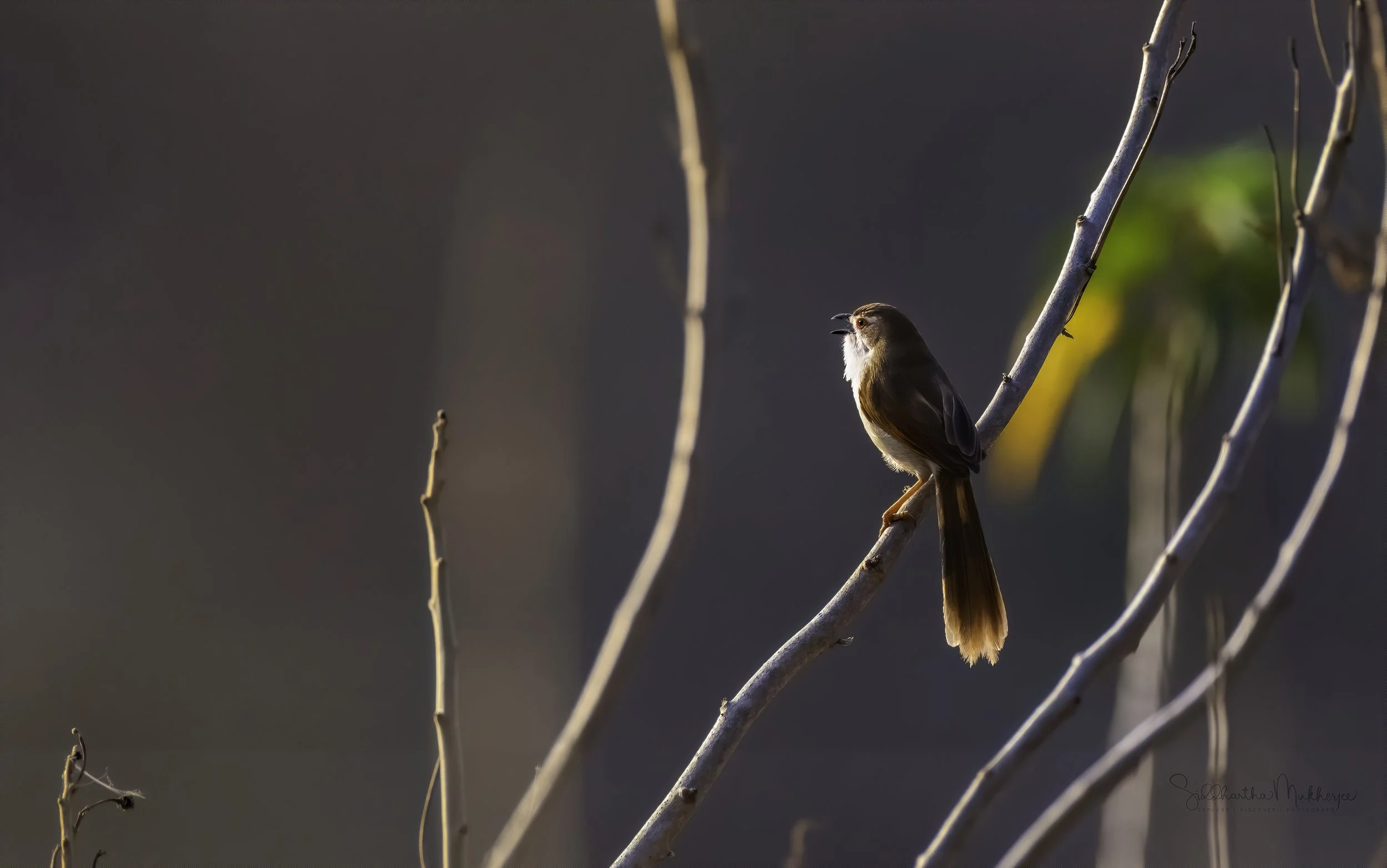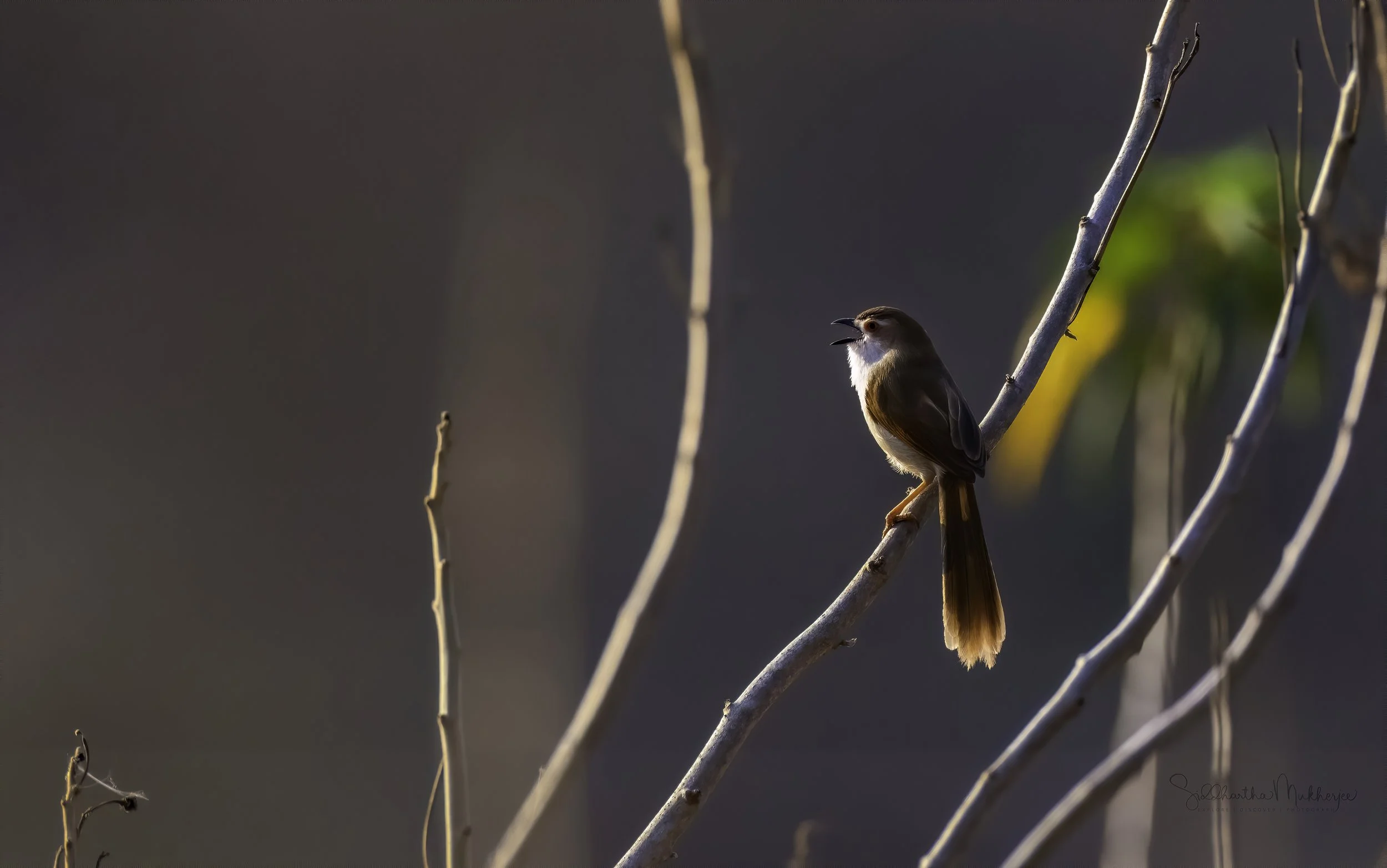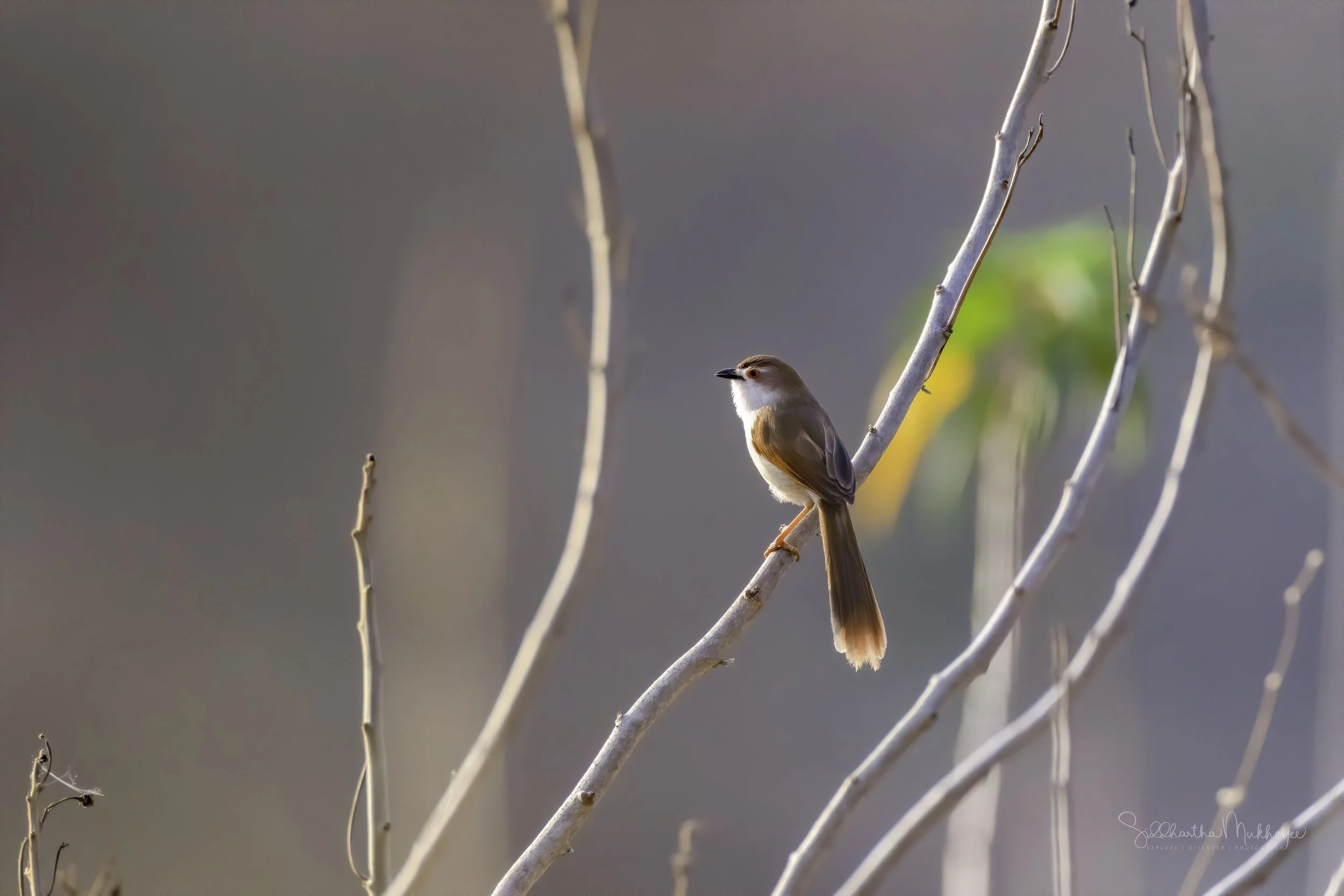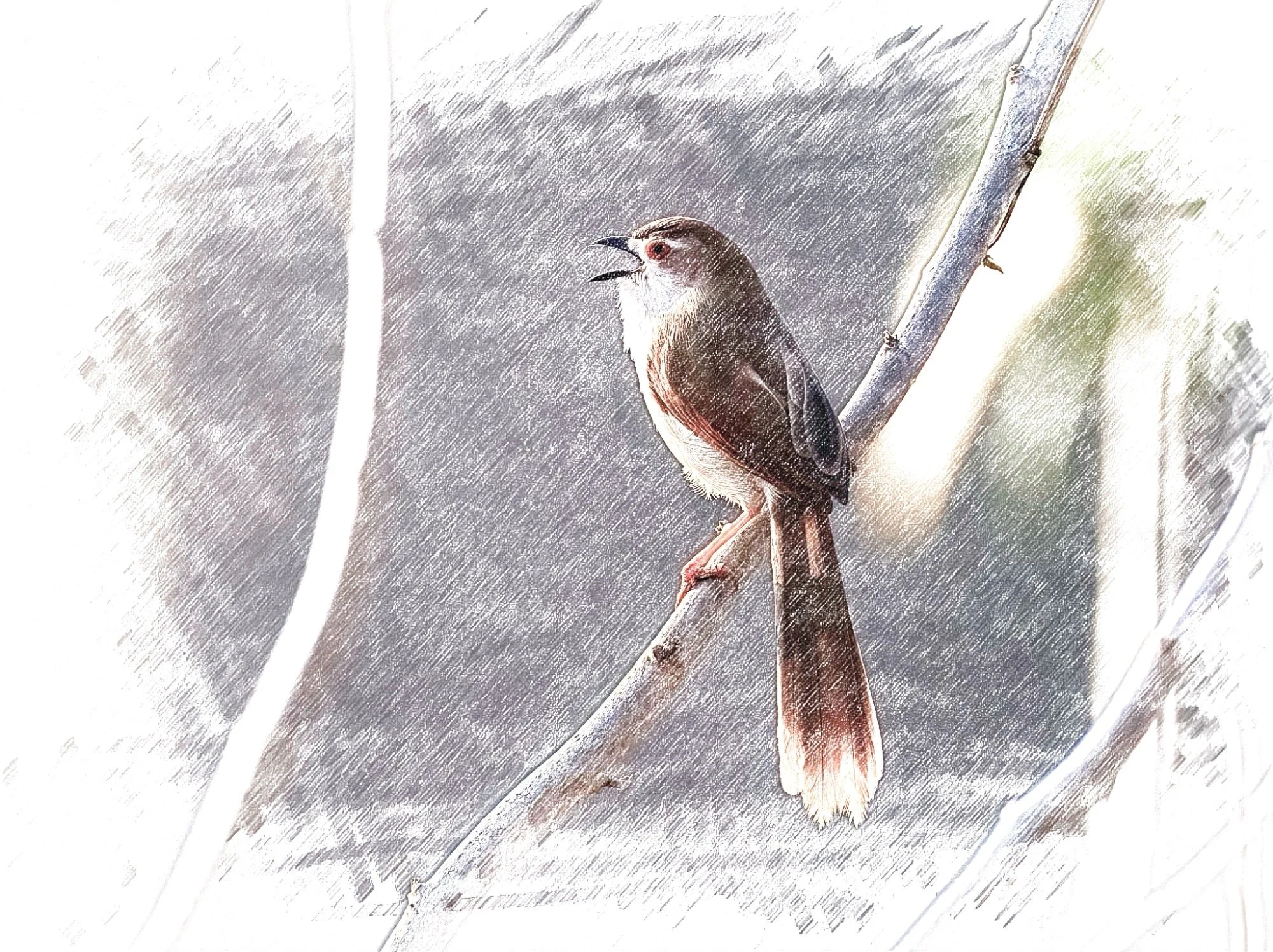Yellow-eyed Babbler
Chrysomma sinense
Gottamgotta, Chincholi Wildlife Sanctuary
For this week, I am exploring deep within the Chincholi Wildlife Sanctuary, near Gottamgotta and the backwaters of the beautiful Chandrampally Dam. I found the Yellow-eyed Babbler perched in this gorgeous early morning light. The waters of the Chandrampally Dam had receded and were far in the distance making for a spectacular dark background against which the bird was beautifully sidelit. This is an odd-looking babbler which looks and behaves like a prinia on steroids. The Yellow-eyed Babbler is brown above and white below with rufous wingtips and a unique red eyering. It scrambles about in reedbeds, scrub, field edges, and grassy meadows in small flocks and pairs. It can be seen scaling stems like a parrotbill and hangs acrobatically like a tit or leaf warbler. Their strident, melodic song has a somewhat hoarse, nasal quality and their calls include repeated descending whistles, energetic chattering, and dry chittering..
Chincholi Wildlife Sanctuary & Gottamgutta
The Chincholi Wildlife Sanctuary is the first dry land Wildlife Sanctuary in South India and was declared a sanctuary in 2011 extending over 134.88 km². This is the only area in the Hyderabad - Karnataka Region with rich floral biodiversity. Apart from medicinal herbs and trees, species like the Red Sanders and Sandalwood are found abundantly. The Sanctuary has good dry deciduous and moist deciduous forest in the core with Acacia and Teak plantations on the fringes. Apart from the Chandrampally dam, four small dams exist at its Centre. The forest is also home to fauna like the Black Buck, Common Fox, Four-horned Antelope, Fruit bat, Hyena, Indian Wolf etc. Over 35 species of birds, including Black Drongo, Black-winged Kite, Blossom-headed Parakeet, Blue pigeon, Black-headed Oriole and Grey partridge are also found. Chincholi is also home to the Lambani Tandas, a protected tribal community that lives locally in the forests in harmony with nature.
I had the opportunity to work with the Forest Range officer stationed here at the time and was able to document almost 35 species of birds within a few hours.
Gottamgutta or Gottamgota is located at a distance of 25 kms from Zaheerabad and 7 KMs from Chandrampalli. Ideally located at the foot of the Chandrampally reservoir on the River Bhima, it provides a fantastic habitat for wildlife to thrive and prosper. The River Bhima (also known as the Chandrabhaga River) is the largest tributary of the Krishna River and a major river in Western and South India. It flows southeast for 861 kilometres through Maharashtra, Karnataka, and Telangana states, before finally merging into the Krishna River. It originates near Bhimashankar Temple in the Bhimashankar hills on the western side of the Western Ghats in the Pune District of Maharashtra. After the first sixty-five kilometers gushing through a narrow valley and rugged terrain, the banks open up and form a fertile agricultural area which is densely populated. It merges into the Krishna River in Karnataka’s Raichur district. Gottamgutta is 135 km from Hyderabad and is ideal for wildlife enthusiasts looking for a weekend drive. Surrounded by lush forests, the hills by the reservoir offer stunning views. The sunlight and moonlight make the water sparkle continuously. Additionally, there is a beautiful waterfall and some ancient temples to explore.
The 861 km-long Bhima river is bounded on the west by the stunning Western Ghats, to the north lies the Balaghat Range, and to the south lie the Mahadeo Hills. The total basin area of the river is 48,631 km², of which 75% lies in the state of Maharashtra. Its water level is prone to monsoonal changes, flooding in August following the rains and almost stagnant between March and April. Receding floodwaters leave rich alluvial terraces that form fertile farming belts. Local irrigation works augment the scant supply of rainfall; major crops are jowar (grain sorghum), bajra (pearl millet), and oilseeds. Sugarcane is an important irrigated cash crop. River Bhima’s major tributaries are the Indrayani River, Mula River, Mutha River, and Pavana River. Pandharpur, an important pilgrimage centre, is located on the right bank of the Bhima. The river is also referred to as Chandrabhaga River, especially at Pandharpur, as it resembles the shape of the Moon.
Till the time I wrote this piece and started looking at the geo tags of my photos and videos I had not realised how much I have photographed and filmed along the River Bhima! And this is just one large tributary of one major river flowing across three states. This illustrates how rich and diverse the biodiversity of India is. Imagine having a record like this for all rivers and their tributaries for the country.
Yellow-eyed Babbler
The Yellow-eyed Babbler (Chrysomma sinense) is a passerine bird native to South and Southeast Asia. It inhabits shrubland, grassland and wetland habitats. On the IUCN Red List, it is listed as Least Concern because of its wide distribution and stable population. Its common name refers to the traditional placement in the Old World Babbler family Timaliidae although the genus Chrysomma forms a clade along with the parrotbills within the family Paradoxornithidae.
The Yellow-eyed Babbler was formally described in 1789 by the German naturalist Johann Friedrich Gmelin in his revised and expanded edition of Carl Linnaeus's Systema Naturae. He placed it with the tits and manakins in the genus Parus and coined the binomial name Parus sinensis. Gmelin based his account on the "Chinese titmouse" that had been described in 1783 by the English ornithologist John Latham in his book A General Synopsis of Birds. Gmelin gave the type locality as China but it is now restricted to the province of Guangdong. The Yellow-eyed Babbler is now placed together with Jerdon's babbler in the genus Chrysomma that was introduced in 1843 by the English zoologist Edward Blyth.
Four subspecies are recognised:
Chrysomma sinense nasale (Legge, 1879) – Distributed in Sri Lanka
Chrysomma sinense hypoleucum (Franklin, 1831) – Distributed in Pakistan (Kohat and Indus Valleys), southwestern and south-central Nepal, and much of India except northeast and featured in this blog
Chrysomma sinense saturatius: Distributed in Northeastern India from northern West Bengal east to Assam & western Arunachal Pradesh (north of Brahmaputra River).
Chrysomma sinense sinense (Gmelin, JF, 1789) – Distributed in Northeastern India (south of the Brahmaputra River), eastern Bangladesh, Myanmar, Thailand (except south and east), southern China (southwestern, southern, and southeastern Yunnan, southwestern Guizhou, Guangxi, western Guangdong), Laos and Vietnam.
The Yellow-eyed babbler is about 18 centimetres long, weighing between 20–24 grams with a short bill and a long graduated tail. The body above is brown and the wings are cinnamon coloured. The lores and supercilium are white and the rim of the eye is orange-yellow in adult birds. The beak is black. The underside is a whitish buff. The central tail feathers are about twice as long as the outermost and the sexes are indistinguishable in the field. The juvenile has darker eyes, brownish lores, less obvious eyering, creamier lower underparts, paler wings and shorter tail. The subspecies differ mainly in plumage coloration, the nominate being less white than the others on the breast and belly. The subspecies nasale is stouter-billed, shorter-tailed and less rufous-tinged above while the subspecies hypoleucum is more sandy-brown with a gray tone above and more rufescent on the wings with only slightly buff-washed below. The subspecies saturatius is darker brown with no rufous tones above, and slightly slaty-tinged brown on crown.
Within its wide distribution range there are some differences in plumage between populations that have been considered as subspecies. The nominate subspecies is found in Burma, Laos and Thailand. The population in Sri Lanka, nasale, has black nostrils and a stouter bill. The population across much of India, hypoleucum, has yellow nostrils (as with the nominate subspecies) and is paler in plumage. The population in the northeast Duars of India has an almost slaty crown and darker wings and has been called as saturatius or saturatior but this is considered as clinal variation and included in the nominate population.
The Yellow-eyed Babbler is resident in its range and prefers scrub, secondary growth, thorn-jungle, tamarisks, brushwood, scrub-covered eroded ravines, edges of cultivation, reedbeds, dry riverbed vegetation, bamboo, cane fields, wet rice fields, open grassland, tall coarse grass, high grass, swamps, fernlands, transitional habitats; enters gardens. Lowlands to 1500 m, to 1830 m in Sri Lanka and Thailand; 500–900 m in Laos.
Its diet consists of caterpillars, grasshoppers (Orthoptera) and other insects, also spiders (Araneae); also berries (Lantana, Salvadora persica), nectar (Erythrina, Salmalia). In pairs; after breeding season in small parties of 5–15 individuals, often in association with various species of prinia (Prinia). It clings to twigs and reed stems sideways or upside-down in manner of a tit (Paridae). They clamber to exposed reedtops to call, before diving into cover and seldom descends to the ground.
The breeding season is between March–November across most of their range and November–July (mainly February–May) in Sri Lanka. The nest is built by both sexes and described as a small, compact, cone-shaped deep cup, made of coarse grasses, fibrous bark strips, dry plant fibers and bamboo leaves, plastered with spider web and seed down, sometimes lichen, lined with fine grasses, grass roots, grass seed heads and stalks, roots and horse hair, suspended between upright stems of reeds, grasses, sugar cane or monsoon plants or wedged in upright fork of small tree, shrub or bush, 0.5–2.1 m above ground. The clutch is 3–5 eggs (usually 4–5 in India, 3 in S India and Sri Lanka), pinkish-white, either thickly and finely mottled and streaked all over with brick-red, or rather sparingly but boldly blotched with irregular patches and lines of bright blood-red or brick-red and usually some pale purple blotches or clouds; incubation by both sexes, no information on duration; nestlings fed by both parents, fledging after 12–13 days.
The Yellow-eyed Babbler is considered not globally threatened. It is uncommon and local in Pakistan and local to fairly common in Nepal, where it is present in the Royal Chitwan National Park. It is widespread and locally common in India, where common in Kalesar Wildlife Sanctuary (in Haryana), present (“seen quite regularly”) in Rajaji National Park and common in Dudhwa National Park (both Uttar Pradesh), occasional in the New Forest campus at Dehra Dun and fairly common in Dehra Dun valley, present in the Buxa Tiger Reserve (West Bengal), occasionally recorded in Kaziranga National Park (Assam), and present in Mudumalai National Park (Tamil Nadu). Widespread but local in Sri Lanka. Rare in the Sundarbans East Wildlife Sanctuary, in Bangladesh. It is locally common in China, where it has been recently recorded in Nonghua, Gulongshan and Diding Nature Reserves, in Guangxi; very common in Yunnan. Generally common in Southeast Asian range: seemingly localized in Indochina, where present in Pu Mat Nature Reserve and uncommon in Nam Bai Cat Tien National Park (Vietnam), and in Phou Dendin and Nakai-Nam Theun National Biodiversity Conservation Areas (Laos); widespread and common in Thailand, although only locally common in Khao Yai National Park.
‡‡‡‡‡
For a print of the beautiful birds from my various sojourns click on the button below to read my process and order a limited edition canvas.
‡‡‡‡‡
Related Posts


